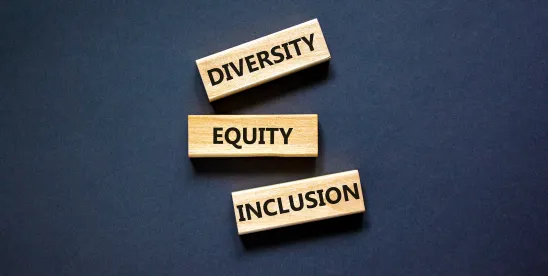On July 29, 2025, Attorney General Pam Bondi issued a memorandum titled “Guidance for Recipients of Federal Funding Regarding Unlawful Discrimination” (the “Memorandum”), responding to the federal government’s recent practice, as Attorney General Bondi puts it, of “turn[ing] a blind eye toward, or even encourag[ing], various discriminatory practices, seemingly because of their purportedly benign labels, objectives, or intentions.” The Memorandum reflects the Trump Administration’s rejection of such practices, and an effort to ensure that entities receiving federal funds do not employ “programs and activities” that “discriminate on the basis of race, color, national origin, sex, religion, or other protected characteristics—no matter the program’s labels, objectives, or intentions.”
In furtherance of this objective, the Memorandum identifies several “Best Practices.” These Best Practices are described “as non-binding suggestions to help entities comply with federal antidiscrimination laws and avoid legal pitfalls; these are not mandatory requirements but rather practical recommendations to minimize the risk of violations.” The Memorandum is targeted at federal government contractors, federal grantees (including, specifically, universities), and state and local governments.
“Unlawful Discriminatory Policies and Practices”
The Memorandum provides a “non-exhaustive list of unlawful practices that could result in revocation of grant funding.” The Memorandum explains that federal funding recipients may be liable not only for engaging in these practices, but also for “the unlawful practices of contractors, grantees, and other third parties” where “they knowingly fund” the violative practices.
- Granting Preferential Treatment Based on Protected Characteristics
- Prohibited Use of Proxies for Protected Characteristics
- The Memorandum defines unlawful “preferential treatment” as “opportunities, benefits, or advantages” provided “to individuals or groups based on protected characteristics in a way that disadvantages other qualified persons, including such practices portrayed as ‘preferential’ to certain groups,” although it acknowledges that such preferences may not violate federal law if they “meet very narrow exceptions,” which are not discussed.
Examples of such practices provided in the Memorandum include:
- Race-based scholarships and programs. These are described as “any race-exclusive opportunities, such as internships, mentorship programs, or leadership initiatives that reserve spots for specific racial groups, regardless of intent to promote diversity.”
- Preferential hiring or promotion practices. The Memorandum provides as an example, “a federally funded entity’s DEI policy [that] prioritizes candidates from ‘underrepresented groups’ for admission, hiring, or promotion, bypassing qualified candidates who do not belong to those groups, where the preferred ‘underrepresented groups’ are determined on the basis of a protected characteristic like race. “
- Access to facilities or resources based on race or ethnicity. The example provided for this practice is, “[a] university’s DEI initiative designates a ‘safe space’ or lounge exclusively for students of a specific racial or ethnic group.”
3. Segregation Based on Protected Characteristics
The Memorandum provides that programs that “separate[] or restrict[] access based on race, sex, or other protected characteristics…. generally violate federal law by creating unequal treatment or reinforcing stereotypes, regardless of the stated goal.” Even so, the Memorandum states that “failing to maintain sex-separated athletic competitions and intimate spaces can also violate federal law.” It states that “allowing males, including those self-identifying as ‘women,’ to access single-sex spaces designed for females—such as bathrooms, showers, locker rooms, or dormitories,” and “permitting males to compete in women’s athletic events” risks “creating a hostile environment under Title VII, particularly where they compromise women’s privacy, safety, or professional standing, and can violate Title IX by denying women access to the full scope of sex-based protections in education.” The Memorandum advises that “organizations should affirm sex-based boundaries rooted in biological differences.”
The following are examples of unlawful practices provided for in the Memorandum:
- Race-Based Training Sessions. For example, “a DEI training program that requires participants to separate into race-based groups (e.g., ‘Black Faculty Caucus’ or ‘White Ally Group’) for discussions, prohibiting individuals of other races from participating in specific sessions,” is identified as an unlawful practice.
- Segregation in Facilities or Resources. Designating spaces in a manner that indicates they are intended for a specific racial group, such as a “BIPOC-only study lounge,” is identified as an unlawful practice as it “discourag[es] access” of individuals of other races. Notably, the Memorandum provides that this practice is problematic “[e]ven if access is technically open to all, [as] the identity-based focus creates a perception of segregation and may foster a hostile environment.”
- Implicit Separation Through Program Eligibility. The Memorandum provides as an example of a problematic practice, hosting “a DEI-focused workshop series that requires participants to identify with a specific racial or ethnic group (e.g., ‘for underrepresented minorities only’) or mandates sex-specific eligibility, effectively excluding others who meet objective program criteria.”
4. Unlawful Use of Protected Characteristics
The Memorandum provides that “consider[ing] race, sex, or any other protected trait as a basis for selecting candidates for employment (e.g., hiring, promotions), contracts (e.g., vendor agreements), or program participation (e.g., internships, admissions, scholarships, training)” constitutes “unlawful use of protected characteristics.” Such practices include “policies that explicitly mandate representation of specific groups in candidate pools or implicitly prioritize protected characteristics through selection criteria.” The Memorandum explains that these practices “violate federal law by creating unequal treatment or disadvantaging otherwise qualified candidates, regardless of any intent to advance diversity goals.” Problematic practices identified in the Memorandum include:
- Race-Based “Diverse Slate” Policies in Hiring. Policies “requiring that all interview slates for … positions include a minimum number of candidates from specific racial groups (e.g., at least two ‘underrepresented minority’ candidates), rejecting otherwise qualified candidates who do not meet this racial criterion,” are identified as unlawful. The Memorandum provides that this includes policies that set “racial benchmarks or mandate[] demographic representation in candidate pools, such as requiring a certain percentage of finalists to be from ‘diverse’ backgrounds.”
- Sex-Based Selection for Contracts. The Memorandum identifies policies that prioritize[] awarding contracts to women-owned businesses, automatically advancing female vendors or minority-owned businesses over equally or more qualified businesses without preferred group status,” as unlawful.
- Race- or Sex-Based Program Participation. The Memorandum provides that “any program—such as scholarships, fellowships, or leadership initiatives—that uses race, sex, or any other protected characteristic as a selection criterion, even if framed as addressing underrepresentation,” can be unlawful. For example, a program that “requires that 50% of selected participants be from ‘underrepresented racial groups’ or female” and that rejects “equally or more qualified applicants who do not meet these demographic criteria” would be unlawful.
5. Training Programs that Promote Discrimination or Hostile Environments
The Memorandum defines “[u]nlawful DEI training programs” as “those that—through their content, structure, or implementation—stereotype, exclude, or disadvantage individuals based on protected characteristics or create a hostile environment.” It includes training that “[e]xcludes or penalizes individuals based on protected characteristics” and “[c]reates an objectively hostile environment through severe or pervasive use of presentations, videos, and other workplace training materials that single out, demean, or stereotype individuals based on protected characteristics.”
The Memorandum provides, as examples of unlawful practices, mandatory training “that “includes statements stereotyping individuals based on protected characteristics—such as ‘all white people are inherently privileged,’ ‘toxic masculinity,’ etc. Such trainings may violate Title VI or Title VII if they create a hostile environment or impose penalties for dissent in ways that result in discriminatory treatment.”
DOJ “Recommendations on Best Practices”
The Memorandum concludes with the following non-binding recommendations on best practices for compliance with federal laws:
- Ensure that all workplace programs, activities and resources are open to all qualified individuals, regardless of protected characteristics. However, “some sex separation is necessary where biological differences implicate privacy, safety, or athletic opportunity.”
- Base “selection decisions on specific, measurable skills and qualifications directly related to job performance or program participation.” The Memorandum states that “[c]riteria like socioeconomic status, first-generation status, or geographic diversity must not be used if selected to prioritize individuals based on racial, sex-based, or other protected characteristics.”
- Eliminate “demographic-driven criteria…designed to achieve discriminatory outcomes.” This includes facially neutral criteria if the purpose is to “increase participation by specific racial or sex-based groups.” Federal funds recipients should instead “use universally applicable criteria, such as academic merit or financial hardship, applied without regard to protected characteristics or demographic goals.”
- Document “clear, legitimate rationales unrelated to race, sex, or other protected characteristics” when “using criteria in hiring, promotions, or selecting contracts that might correlate with protected characteristics.”
- “Rigorously evaluate” facially neutral criteria, such as programs for “low-income students,” to determine whether “they are proxies for race, sex, or other protected characteristics,” to ensure they are not implemented in a way that intends to “achieve racial or sex-based outcomes.” Such evaluations should be documented.
- Eliminate “diversity quotas,” which includes policies that require representation based on protected characteristics, such as mandating “representation of specific racial, sex-based, or other protected groups in candidate pools, hiring panels, or final selections.”
- “Avoid exclusionary training programs” by ensuring that trainings “are open to all qualified participants” and do not segregate participants into groups based on protected characteristics. Further, trainings “should not require participants to affirm specific ideological positions or ‘confess’ to personal biases or privileges based on a protected characteristic.”
- Include “explicit nondiscrimination clauses” in contracts with third parties: (1) specifying that federal funds “cannot be used for programs that discriminate based on protected characteristics”; and (2) “requiring third parties to comply with federal laws.” The Memorandum also recommends that federal funds recipients monitor “third parties that receive federal funds to ensure ongoing compliance, including reviewing program materials, participant feedback, and outcomes, to identify potential discriminatory practices.”
- Establish confidential reporting channels and explicit anti-retaliation policies for individuals who engage in protected activity, “such as raising concerns, filing complaints, or refusing to participate in potentially discriminatory programs.” These policies should be included in “employee handbooks, student codes of conduct, and program guidelines.”
Conclusion
The Memorandum provides additional guidance on how the current Administration views federal anti-discrimination laws. Particularly given the False Claims Act liability, federal contractors, subcontractors, and grant recipients must become familiar with these guidelines, and should review their policies and practices with the support of legal counsel in order to ensure compliance with federal laws requiring equal treatment.





 />i
/>i

